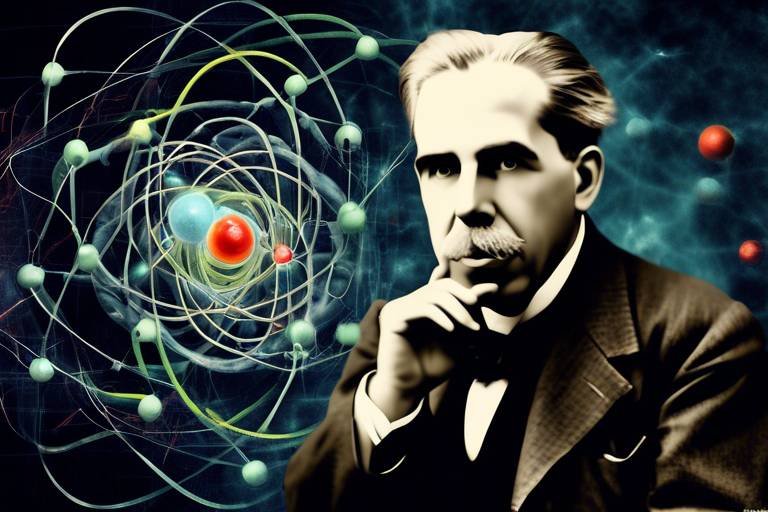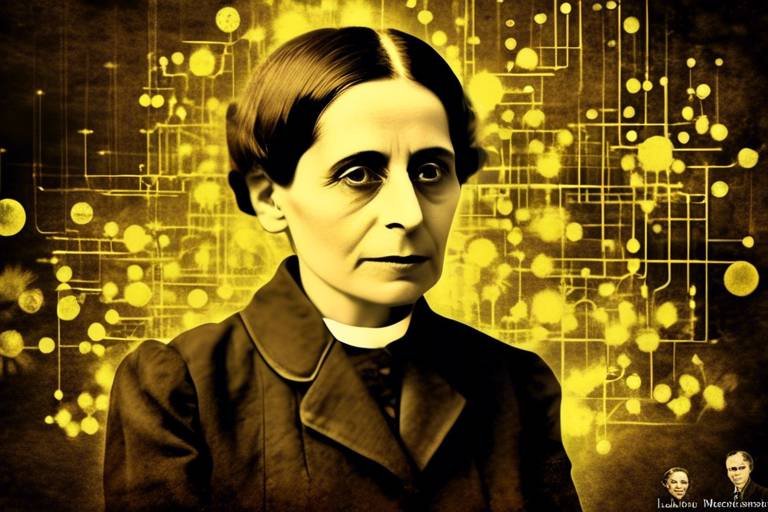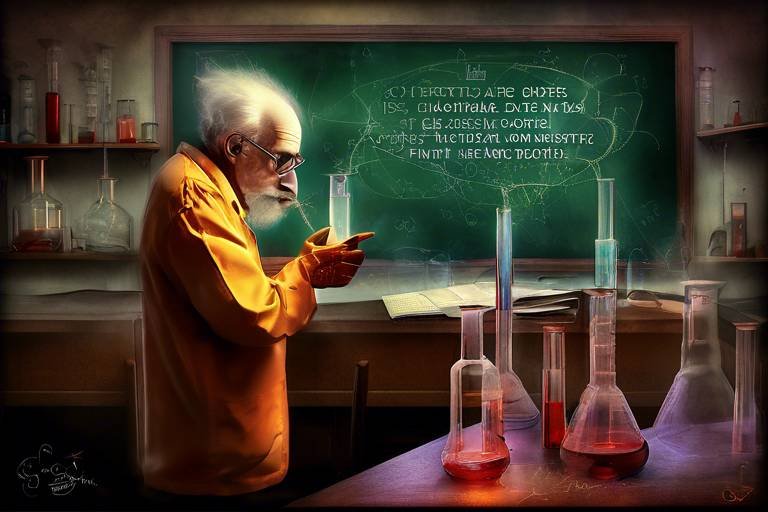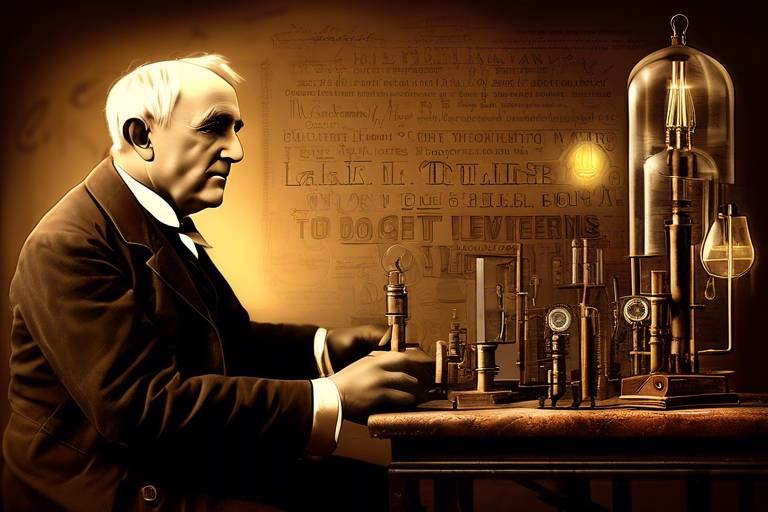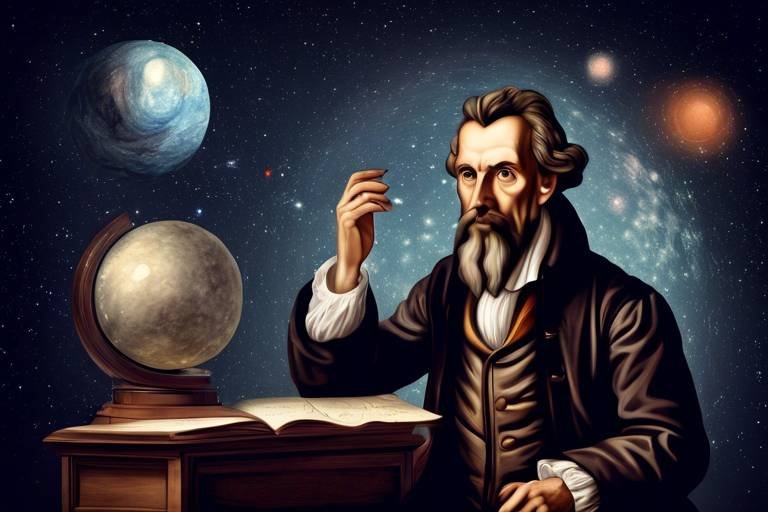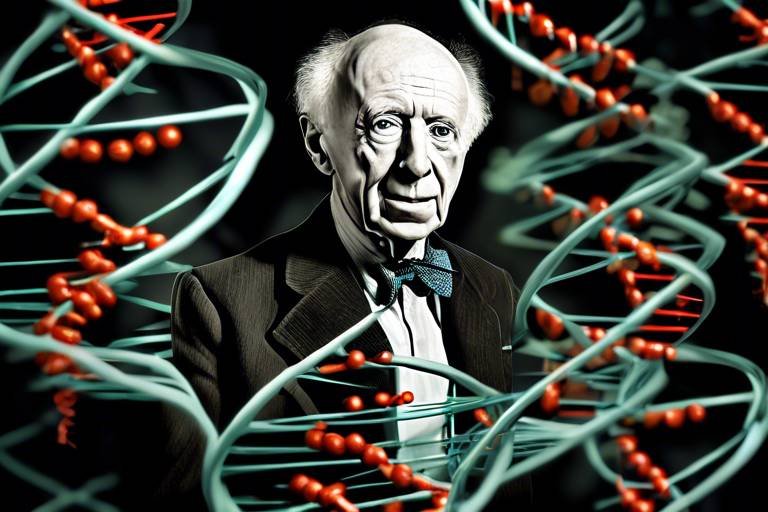The Work of Max Planck and Quantum Theory
Max Planck's contributions to quantum theory are nothing short of revolutionary. Imagine a world where the very fabric of reality is woven from tiny, indivisible threads of energy. This was the groundbreaking insight Planck introduced in the early 20th century, fundamentally altering our understanding of physics and the universe as a whole. His work not only solved critical problems of his time but also paved the way for an entirely new branch of science that would challenge the classical views held for centuries.
Before diving into the details of his discoveries, it’s essential to appreciate the context in which Planck operated. At the turn of the century, physicists were grappling with perplexing phenomena that classical physics could not explain. The study of thermal radiation, particularly blackbody radiation, posed a significant challenge. Classical theories predicted that a black body would emit radiation at all wavelengths, leading to what is known as the "ultraviolet catastrophe." This inconsistency was a major thorn in the side of physicists, and it was here that Planck stepped in with his innovative ideas.
Planck proposed that energy is not continuous but rather exists in discrete packets, which he termed "quanta." This idea was radical; it was akin to suggesting that instead of a smooth, flowing river, energy behaves more like a series of discrete stepping stones. By introducing the concept of quantization, Planck not only solved the blackbody radiation problem but also laid the groundwork for what would become quantum mechanics. His work was like a key that unlocked a door to a new realm of understanding, where particles could exist in multiple states and energies could be quantized.
As we explore the implications of Planck's work, it becomes clear that his discoveries were not just theoretical musings. They had profound consequences for thermodynamics, the study of heat and energy. Planck's findings challenged existing theories and offered fresh insights into the relationship between energy and entropy. It was as if he had illuminated a darkened room, revealing connections and relationships that had previously gone unnoticed. The ripple effects of his work would influence not just his contemporaries but generations of scientists to come.
In summary, Max Planck's introduction of quantum theory was a game-changer. It transformed the landscape of physics and opened up new avenues for exploration and discovery. His legacy is not only preserved in scientific literature but also lives on through institutions like the Max Planck Society, which continues to foster groundbreaking research in various fields. The world of quantum mechanics that we know today owes much to the pioneering spirit of Max Planck, whose insights continue to resonate in modern physics.
- What is quantum theory? Quantum theory is a fundamental theory in physics that describes the physical properties of nature at the scale of atoms and subatomic particles.
- Why is Max Planck important? Max Planck is considered the father of quantum theory; his work laid the foundation for modern physics and changed our understanding of energy and matter.
- What is Planck's constant? Planck's constant is a fundamental constant that relates the energy of a photon to its frequency, playing a critical role in quantum mechanics.
- How did Planck's work influence thermodynamics? Planck's findings introduced new concepts of energy quantization, which challenged classical thermodynamics and led to a deeper understanding of energy and entropy.

Max Planck's Early Life
Max Planck was born on April 23, 1858, in the charming city of Kiel, Germany. From a young age, he displayed an insatiable curiosity about the world around him. His family was steeped in academic tradition, with his father serving as a law professor and his mother coming from a family of educators. This intellectual environment undoubtedly fueled Planck's passion for science.
Planck's educational journey began at the University of Munich, where he initially studied physics. However, he didn't just stop at physics; he also dabbled in other disciplines, including mathematics and philosophy. This diverse academic background helped him develop a well-rounded perspective that would later be crucial in his scientific endeavors. Imagine trying to solve a puzzle where each piece represents a different field of study—this is how Planck approached his education.
During his time at university, he was influenced by prominent scientists, including the renowned physicist Wilhelm Röntgen, who later discovered X-rays. These early interactions sparked Planck's interest in the laws of thermodynamics and electromagnetic radiation, which would become the cornerstones of his future work. In 1879, he earned his doctorate with a dissertation on the second law of thermodynamics, which was a significant achievement for a young scientist. It was as if he had laid the first stone in the foundation of quantum theory.
Planck's early career was not without its challenges. He faced skepticism from the scientific community regarding his unconventional ideas. However, his determination and resilience allowed him to persevere. He accepted a position at the University of Berlin, where he would spend the majority of his professional life. This was a pivotal moment for Planck, as it provided him with the platform to explore his groundbreaking theories. Picture a seed planted in fertile soil; this environment nurtured his ideas, allowing them to grow and flourish.
In addition to his academic pursuits, Planck's personal life was also marked by significant events. He married Marie Merck in 1887, and the couple had five children. Tragically, Planck's family life was marred by the loss of several of his children, which profoundly affected him. Despite these personal hardships, Planck continued to push the boundaries of science, driven by a desire to understand the universe.
In summary, Max Planck's early life was characterized by a blend of intellectual curiosity, academic achievement, and personal challenges. His formative years laid the groundwork for the revolutionary ideas that would eventually lead to the development of quantum theory. Just as a sculptor chisels away at a block of marble to reveal a masterpiece, Planck's early experiences shaped him into one of the most influential physicists in history.

The Quantum Hypothesis
The quantum hypothesis introduced by Max Planck in the early 20th century was nothing short of revolutionary. It proposed a radically new way of understanding energy, suggesting that it is not continuous, as previously thought, but rather exists in discrete packets called quanta. This idea was a game changer, fundamentally altering the landscape of physics. Imagine trying to pour water into a glass: if the water represented energy, classical physics treated it as a continuous flow. But Planck's hypothesis said, "Hold on! What if we can only pour it in fixed amounts, like ice cubes?" This concept was not only surprising but also opened the floodgates for a multitude of new theories and discoveries.
Before Planck's groundbreaking work, scientists were grappling with the blackbody radiation problem. Classical physics struggled to explain why objects emitted radiation differently at various temperatures. The existing theories failed spectacularly at higher frequencies, leading to what is now known as the ultraviolet catastrophe. Planck's insight was to introduce the idea that energy could only be emitted or absorbed in these quantized units, thus providing a solution that aligned perfectly with experimental data. This was the birth of the quantum theory, a concept that would eventually lead to the development of modern physics.
To better understand the implications of the quantum hypothesis, let's break down its key components:
- Energy Quantization: Energy is emitted or absorbed in discrete amounts, challenging the classical view of energy as a continuous entity.
- Planck's Constant: The introduction of a fundamental constant (denoted as h) that quantifies the size of these energy packets.
- Thermal Radiation: The hypothesis provided a new framework for understanding how objects emit radiation based on their temperature.
Planck's quantum hypothesis did not just solve a pressing scientific issue; it paved the way for future physicists to explore the strange and fascinating world of quantum mechanics. Think of it as a key that unlocked a door to a new dimension of understanding—one where particles could exist in multiple states, where uncertainty reigns, and where the very fabric of reality is woven from probabilities rather than certainties.
This shift in perspective was monumental. It led to a cascade of discoveries, influencing not only theoretical physics but also practical applications in technology, chemistry, and even information science. The quantum hypothesis, initially a solution to a specific problem, blossomed into a comprehensive framework that redefined our grasp of the universe. The implications of Planck's work are still felt today, as we continue to unravel the mysteries of quantum phenomena and their applications in fields such as quantum computing and cryptography.

The Blackbody Radiation Problem
The blackbody radiation problem is one of the most intriguing challenges in the realm of physics, primarily because it highlights a significant gap in our understanding of energy distribution at the atomic level. Imagine a perfect blackbody as an idealized physical object that absorbs all incident electromagnetic radiation, regardless of frequency or angle. It's like a sponge soaking up water—no reflection, no transmission, just total absorption. This concept was crucial for scientists in the late 19th century as they sought to explain how objects emit radiation when heated.
Before Max Planck stepped onto the scene, classical physics struggled to explain the observed spectrum of radiation emitted by blackbodies. According to classical theories, particularly Rayleigh-Jeans law, the intensity of radiation emitted should increase infinitely as the wavelength decreases, leading to what was humorously dubbed the "ultraviolet catastrophe." In essence, classical physics predicted that at short wavelengths, the energy emitted would be infinite, which was clearly at odds with experimental evidence. This discrepancy was alarming and called for a revolutionary approach to understanding energy at the microscopic level.
Planck's breakthrough came in 1900 when he proposed that energy is not emitted continuously, but rather in discrete packets called quanta. This was a radical departure from the classical view. To illustrate this, think of energy as a staircase rather than a ramp; you can step up or down only in fixed increments rather than smoothly transitioning. This quantization of energy fundamentally changed the way scientists approached thermal radiation and laid the groundwork for the development of quantum mechanics.
To better understand the implications of Planck's work, let’s take a look at how blackbody radiation was characterized before and after his hypothesis:
| Aspect | Classical Physics (Rayleigh-Jeans Law) | Quantum Theory (Planck's Hypothesis) |
|---|---|---|
| Energy Emission | Continuous | Quantized |
| Behavior at Short Wavelengths | Predicted infinite intensity | Finite intensity, approaches zero |
| Key Formula | Rayleigh-Jeans Law | Planck's Law |
Planck's law describes the spectral density of electromagnetic radiation emitted by a black body in thermal equilibrium and is mathematically expressed as:
I(ν, T) (8πhν^3)/(c^3) * (1/(e^(hν/kT) - 1))
In this equation, I(ν, T) represents the intensity of radiation at frequency ν and temperature T, while h is Planck's constant, c is the speed of light, and k is Boltzmann's constant. This formula not only resolved the blackbody radiation problem but also opened the door to a new understanding of thermodynamics and quantum mechanics.
In summary, the blackbody radiation problem was more than just a scientific puzzle; it was the catalyst for a profound shift in our understanding of the physical universe. Max Planck's innovative approach to energy quantization not only solved this dilemma but also laid the foundation for the entire field of quantum physics. His work is a reminder that sometimes, the key to unlocking the mysteries of the universe lies in rethinking our fundamental assumptions.
- What is a blackbody? A blackbody is an idealized object that perfectly absorbs all incoming radiation and re-emits energy in a characteristic spectrum based on its temperature.
- Why was the blackbody radiation problem significant? It highlighted the limitations of classical physics and prompted the development of quantum theory, revolutionizing our understanding of energy at the atomic level.
- What is Planck's constant? Planck's constant is a fundamental constant that relates the energy of a photon to its frequency, playing a crucial role in quantum mechanics.

Planck's Law of Radiation
Max Planck's Law of Radiation is a cornerstone of modern physics, and it emerged from his groundbreaking work on blackbody radiation. To put it simply, Planck's law describes how electromagnetic radiation is emitted by a black body in thermal equilibrium. Imagine a perfect radiator that absorbs all incoming light and reflects none—this is what a black body is. The law provides a mathematical formula that allows us to predict the intensity of radiation emitted at different wavelengths for a given temperature.
At its core, Planck's law reveals that the intensity of radiation emitted increases with temperature and varies with wavelength. This means that as an object gets hotter, it emits more energy, and the peak of its emission shifts to shorter wavelengths. For instance, a piece of iron changes from red to white as it is heated, showcasing this shift in color due to the change in emitted radiation. The mathematical expression for Planck's law is:
I(λ, T) (2hc² / λ⁵) * (1 / (e^(hc / λkT) - 1))
In this equation, I(λ, T) represents the spectral radiance, λ is the wavelength, T is the absolute temperature, h is Planck's constant, c is the speed of light, and k is the Boltzmann constant. This formula not only illustrates the relationship between temperature and emitted radiation but also incorporates the concept of quantized energy levels, which was revolutionary at the time.
One of the most intriguing aspects of Planck's law is its departure from classical physics. Before Planck, scientists relied on the Rayleigh-Jeans law, which predicted that the intensity of radiation would increase indefinitely with decreasing wavelength, leading to what is known as the "ultraviolet catastrophe." Planck's introduction of quantization resolved this dilemma, providing a finite value for the intensity of radiation emitted at high frequencies. This was a pivotal moment that helped bridge the gap between classical and quantum physics.
In summary, Planck's Law of Radiation not only quantifies how energy is emitted by black bodies but also fundamentally changed our understanding of thermal radiation. It laid the groundwork for quantum mechanics and influenced many future discoveries in physics. The implications of this law extend beyond theoretical physics; they have practical applications in various fields, including thermodynamics, astrophysics, and even the development of modern technologies like lasers and photodetectors. Planck's work reminds us that the universe operates on principles that can sometimes defy our intuitive understanding, and it invites us to explore the depths of the quantum world.
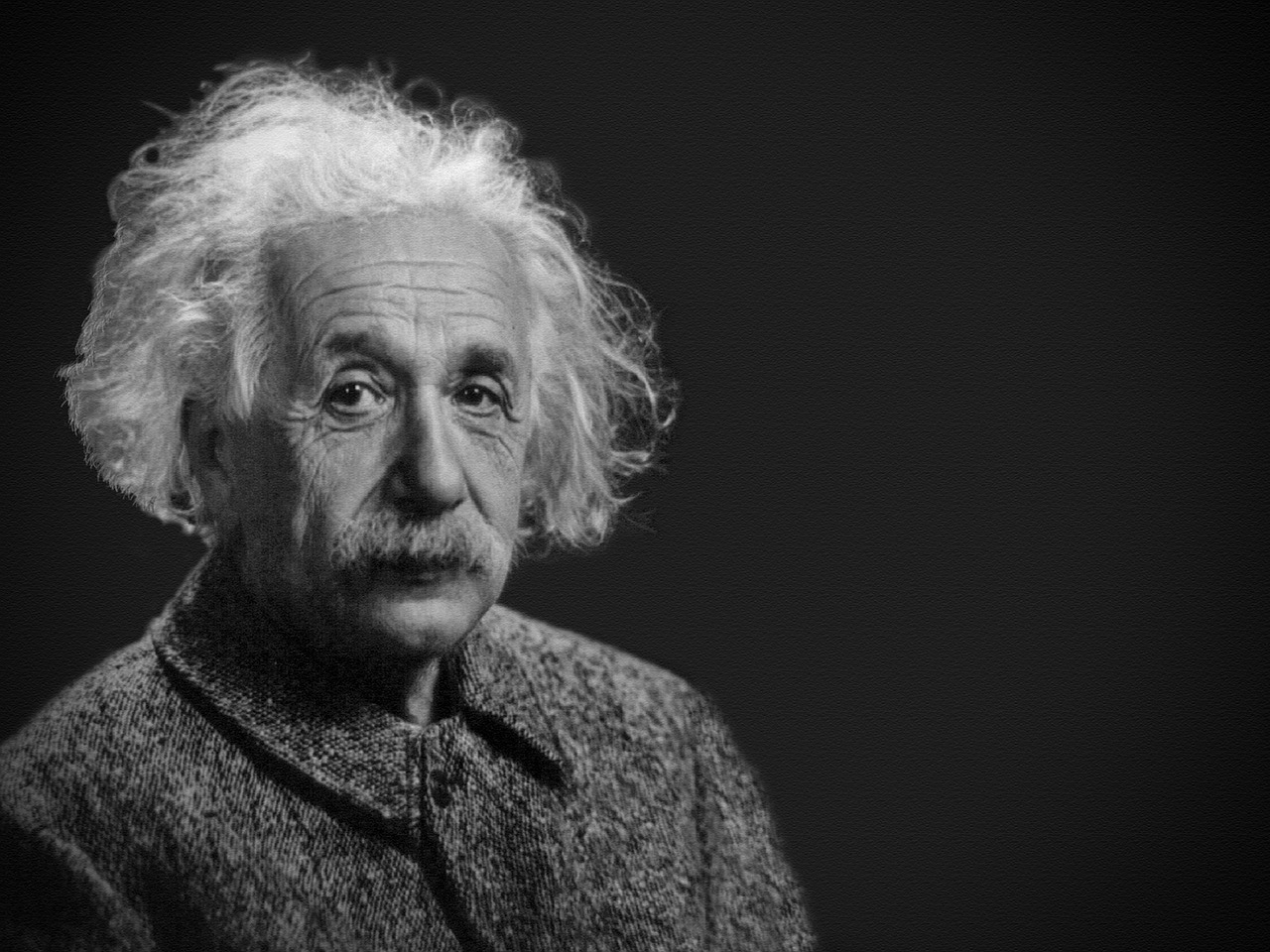
Implications for Thermodynamics
Max Planck's groundbreaking discoveries did not just shake the foundations of physics; they also had profound implications for the field of thermodynamics. Before Planck's work, thermodynamics was primarily built on classical physics principles, which struggled to explain certain phenomena, particularly at the atomic and subatomic levels. Planck's introduction of the quantum hypothesis fundamentally altered this landscape, suggesting that energy is not continuous but rather exists in discrete packets, or quanta. This revelation was akin to discovering that a smooth, flowing river was actually made up of individual, bouncing pebbles.
One of the most significant implications of Planck's work was the challenge it posed to the second law of thermodynamics. This law, which states that the total entropy of an isolated system can never decrease over time, was traditionally understood in the context of classical energy distribution. However, Planck's findings indicated that energy distribution among particles could be quantized, leading to a new understanding of how energy and entropy interact at microscopic levels. In essence, this meant that the way we viewed energy exchanges needed a significant overhaul, pushing scientists to reevaluate many established theories.
Furthermore, Planck's law of radiation, derived from his quantum hypothesis, provided a mathematical framework for understanding how energy is emitted and absorbed by matter. This law not only resolved the blackbody radiation problem but also laid the groundwork for the development of statistical mechanics, which describes the behavior of systems with a large number of particles. By incorporating quantum principles, statistical mechanics could explain phenomena that classical thermodynamics could not, such as the behavior of gases at very low temperatures or the specific heat of solids.
To illustrate the impact of Planck's findings, consider the following table that highlights key differences between classical thermodynamics and the quantum approach:
| Aspect | Classical Thermodynamics | Quantum Thermodynamics |
|---|---|---|
| Energy Distribution | Continuous | Quantized |
| Entropy Behavior | Always increases | Can exhibit fluctuations |
| Temperature Relations | Macroscopic | Microscopic |
| Statistical Mechanics | Based on classical particles | Incorporates quantum states |
This table underscores the shift in understanding that Planck's work initiated. By recognizing that energy could be quantized, scientists began to explore new avenues in thermodynamics, leading to advancements in fields such as quantum computing and nanotechnology. The implications of Planck's discoveries are not just historical; they continue to influence modern scientific research and technological development.
In summary, Max Planck's contributions to thermodynamics were nothing short of revolutionary. His insights into the quantization of energy opened up a new realm of possibilities, challenging the status quo and inviting scientists to rethink the very nature of energy and entropy. As we delve deeper into the quantum world, we can appreciate how Planck's legacy continues to shape our understanding of the universe.
- What is Max Planck known for?
Max Planck is best known for his role in the development of quantum theory, particularly for introducing the concept of quantized energy levels. - How did Planck's work influence modern physics?
Planck's work laid the groundwork for quantum mechanics, influencing prominent scientists like Albert Einstein and Niels Bohr. - What is Planck's constant?
Planck's constant is a fundamental constant that relates the energy of a photon to its frequency, serving as a bridge between classical and quantum physics. - Why is the concept of quantization important?
Quantization is crucial because it explains phenomena that classical physics cannot, such as the behavior of particles at microscopic levels.

Planck's Constant
When we talk about , we're diving into the very essence of quantum mechanics. This tiny number, denoted as h, plays a monumental role in the world of physics, acting as a bridge between the classical and quantum realms. But what exactly is Planck's constant, and why is it so crucial? Well, let's unpack this intriguing concept.
Planck's constant is defined as approximately 6.626 × 10-34 J·s. At first glance, this may seem like just another number, but it holds profound implications. It signifies the smallest action in the universe, essentially the minimum amount of energy that can be exchanged in the form of electromagnetic radiation. Think of it as the universe's "speed limit" for energy transfer. Just as you can't drive faster than a certain speed, energy interactions can't occur in smaller increments than what Planck's constant allows.
To illustrate its significance, let's consider how Planck's constant is fundamentally woven into the fabric of quantum mechanics. It appears in several pivotal equations, including the famous E hν, where E is energy, h is Planck's constant, and ν (nu) is the frequency of the radiation. This relationship reveals that energy is not continuous, but rather quantized, meaning it exists in discrete packets or "quanta." This was a radical departure from classical physics, which treated energy as a smooth continuum.
| Parameter | Value |
|---|---|
| Planck's Constant (h) | 6.626 × 10-34 J·s |
| Energy (E) | Varies with frequency (ν) |
| Frequency (ν) | Measured in Hz (cycles per second) |
Planck's constant also plays a vital role in the Heisenberg Uncertainty Principle, which states that certain pairs of physical properties, like position and momentum, cannot be simultaneously known to arbitrary precision. The uncertainty in these measurements is fundamentally tied to the value of Planck's constant, emphasizing just how deeply it influences the behavior of particles at the quantum level.
Furthermore, Planck's constant has implications beyond theoretical physics; it is essential in various applications, including quantum computing, photovoltaics, and even in the development of lasers. Without this constant, our understanding of the atomic and subatomic worlds would be dramatically different, and many technologies we take for granted today might not exist.
In summary, Planck's constant is not just a number; it is a revolutionary concept that reshaped our understanding of energy and matter. It serves as a reminder that the universe operates on principles that often defy our classical intuitions. As we continue to explore the depths of quantum mechanics, Planck's constant will undoubtedly remain a cornerstone of scientific inquiry, challenging us to think differently about the nature of reality.

Impact on Quantum Mechanics
Max Planck's groundbreaking work laid the foundation for quantum mechanics, a field that would redefine our understanding of the universe. His introduction of the quantum hypothesis was not just a minor tweak in the existing theories; it was akin to flipping the entire script of physics. Imagine standing on the edge of a vast ocean of knowledge, and then suddenly discovering a whole new world beneath the surface. That's what Planck did for science. His ideas opened the door to a realm where particles behaved in ways that were previously unimaginable, challenging the very fabric of classical physics.
Following Planck's revelations, renowned physicists like Albert Einstein and Niels Bohr took the baton and sprinted with it, further developing the principles of quantum theory. Einstein, for instance, expanded on Planck's ideas to explain the photoelectric effect, which demonstrated that light could behave as both a wave and a particle. This duality was a game-changer, illustrating that the universe doesn't always adhere to our intuitive notions of reality. In a sense, it was as if Planck had handed a key to a locked door, and Einstein burst through to explore the uncharted territories beyond.
Moreover, the collaboration among scientists during this period was crucial. The scientific community began to piece together the puzzle of quantum mechanics, and Planck’s work served as the cornerstone. His discussions and exchanges with contemporaries contributed significantly to the development of theories that would later become fundamental to our understanding of atomic and subatomic processes. The synergy of ideas during this time can be likened to a symphony, where each physicist played a unique instrument, harmonizing their discoveries to create a beautiful and complex understanding of the quantum world.
To illustrate the impact of Planck's work, consider the following table that summarizes key contributions and their significance:
| Contribution | Scientist | Significance |
|---|---|---|
| Quantum Hypothesis | Max Planck | Proposed that energy is quantized, altering the understanding of thermal radiation. |
| Photoelectric Effect | Albert Einstein | Demonstrated light's dual nature, reinforcing quantum theory. |
| Bohr Model of the Atom | Niels Bohr | Introduced quantized orbits for electrons, explaining atomic structure. |
As the quantum revolution unfolded, it became clear that Planck's influence extended far beyond his own discoveries. The implications of his work permeated various fields, including chemistry and material science, leading to innovations that have shaped modern technology. Think about the devices we use today, from smartphones to lasers; many of these rely on principles that stem from quantum mechanics. In essence, Planck didn’t just change physics; he altered the very course of human innovation.
In conclusion, Max Planck's contributions to quantum mechanics are monumental. His pioneering ideas not only challenged the status quo but also inspired an entire generation of scientists to explore the mysteries of the atomic world. As we continue to delve deeper into quantum theory, we owe a great debt to Planck, whose work remains a beacon of curiosity and innovation. The universe, as we now understand it, is a testament to his vision and perseverance.
- What did Max Planck contribute to quantum mechanics?
Max Planck introduced the concept of quantization of energy, which became the foundation for quantum theory.
- Why is Planck's constant important?
Planck's constant is a fundamental quantity that relates the energy of a photon to its frequency, bridging classical and quantum physics.
- How did Planck's work influence future scientists?
Planck's ideas inspired scientists like Einstein and Bohr, leading to significant advancements in quantum mechanics and our understanding of the atomic structure.

Collaboration with Other Scientists
Max Planck's journey through the realm of physics was not a solitary one; it was enriched by his collaborations with other brilliant minds of his time. These partnerships were pivotal in shaping the landscape of quantum mechanics and advancing scientific understanding. For instance, Planck had a close professional relationship with Albert Einstein, who, inspired by Planck's work, introduced the idea of light quanta, or photons. This relationship was not just a meeting of minds but a fusion of revolutionary ideas that propelled physics into a new era.
Another significant collaboration was with Niels Bohr, who expanded on Planck's quantum theory. Bohr's model of the atom, which incorporated Planck's quantization of energy levels, provided a clearer picture of atomic structure. This partnership exemplifies how Planck's initial hypotheses laid the groundwork for further theoretical advancements. In many ways, Planck was the seed from which a vast forest of quantum theories grew.
Furthermore, Planck's involvement with the German Physical Society allowed him to engage with a plethora of physicists, fostering a collaborative spirit that was essential for scientific progress. Through conferences and discussions, he exchanged ideas with contemporaries like Wilhelm Wien and Max von Laue, both of whom contributed to the understanding of radiation and quantum phenomena. These interactions not only enriched Planck's own research but also helped to create a community of scientists dedicated to unraveling the mysteries of the universe.
To illustrate the breadth of Planck's collaborations, consider the following table, which highlights some key figures who influenced or were influenced by his work:
| Scientist | Contribution |
|---|---|
| Albert Einstein | Introduced the concept of light quanta, building on Planck's quantum hypothesis. |
| Niels Bohr | Developed the Bohr model of the atom, integrating Planck's ideas on quantization. |
| Wilhelm Wien | Contributed to the understanding of blackbody radiation, complementing Planck's findings. |
| Max von Laue | Investigated the diffraction of X-rays, which was influenced by quantum theory. |
In conclusion, Max Planck's collaborations were not just professional relationships; they were vital connections that sparked innovative ideas and propelled the scientific community forward. The dialogues and debates he engaged in with other scientists were crucial in transforming quantum theory from a fledgling idea into a robust framework that continues to influence modern physics. Through these collaborations, Planck's legacy is not only preserved but also expanded, as each new generation of physicists builds on the foundations he laid.
- What is Max Planck best known for?
Max Planck is best known for his role in the development of quantum theory, particularly his introduction of the concept of quantized energy. - How did Planck's work influence other scientists?
Planck's work laid the groundwork for future physicists like Einstein and Bohr, who built upon his theories to develop modern quantum mechanics. - What is Planck's constant?
Planck's constant is a fundamental quantity in quantum mechanics that relates the energy of a photon to its frequency, serving as a bridge between classical and modern physics.

Legacy of Max Planck
Max Planck's legacy is nothing short of monumental in the realm of science. His pioneering work in quantum theory not only transformed physics but also laid the groundwork for numerous technological advancements that we often take for granted today. Imagine a world where the fundamental principles of energy and matter were still shrouded in mystery; Planck's insights illuminated the path forward, enabling us to understand the universe at a microscopic level.
One of the most significant aspects of Planck's legacy is the establishment of the Max Planck Society, which was founded in 1948. This renowned research organization has become a global leader in scientific research, fostering innovation in various fields including physics, biology, and social sciences. The society continues to honor Planck's commitment to scientific excellence and collaboration, supporting thousands of researchers who strive to push the boundaries of human knowledge.
Furthermore, Planck's introduction of Planck's constant, a fundamental physical constant, has become a cornerstone in the field of quantum mechanics. It serves as a bridge between the classical and quantum worlds, influencing everything from the development of semiconductors to the understanding of black holes. The implications of his constant are vast, permeating various scientific disciplines and shaping modern technology.
| Year | Event |
|---|---|
| 1900 | Planck introduces the quantum hypothesis. |
| 1918 | Planck awarded the Nobel Prize in Physics. |
| 1948 | Establishment of the Max Planck Society. |
| 2000s | Planck's theories inspire advancements in quantum computing. |
Planck's influence extends beyond academia. His ideas have permeated popular culture, inspiring countless books, films, and discussions about the nature of reality. He has become a symbol of scientific inquiry and intellectual courage, reminding us that the quest for knowledge often requires us to challenge established norms and think beyond the obvious.
In addition to his scientific contributions, Planck was also a mentor to many prominent physicists, including Albert Einstein and Niels Bohr. His guidance and support helped shape the next generation of scientists who would further develop and refine quantum theory. The collaborative spirit he fostered among his peers is a testament to the importance of teamwork in scientific discovery.
In conclusion, Max Planck's legacy is characterized by his groundbreaking contributions to quantum theory, the establishment of institutions dedicated to scientific research, and the inspiration he continues to provide to scientists and thinkers around the world. His work is a reminder that the pursuit of knowledge is an ongoing journey, one that requires curiosity, creativity, and the courage to question the status quo.
- What is Max Planck known for? Max Planck is best known for his foundational work in quantum theory, particularly for introducing the concept of quantized energy.
- What is Planck's constant? Planck's constant is a fundamental physical constant that relates the energy of a photon to its frequency, serving as a bridge between classical and quantum physics.
- How did Planck's work influence modern physics? Planck's work laid the groundwork for the development of quantum mechanics, influencing many subsequent scientists and leading to advancements in various fields including technology and cosmology.
Frequently Asked Questions
- What is Max Planck known for?
Max Planck is best known for his groundbreaking work in quantum theory. He introduced the concept that energy is quantized, which fundamentally changed our understanding of physics and laid the groundwork for modern quantum mechanics.
- What is the quantum hypothesis?
The quantum hypothesis, proposed by Planck, suggests that energy is not continuous but instead comes in discrete packets called "quanta." This idea was revolutionary as it challenged classical physics and provided a new framework for understanding phenomena like blackbody radiation.
- What was the blackbody radiation problem?
The blackbody radiation problem refers to the difficulty classical physics faced in explaining the observed spectrum of radiation emitted by a perfect black body. Planck's work on this problem led to the formulation of his law of radiation, which accurately describes the spectral density of electromagnetic radiation.
- What is Planck's law of radiation?
Planck's law of radiation describes the intensity of radiation emitted by a black body in thermal equilibrium as a function of wavelength. It is mathematically expressed and shows how energy distribution varies with temperature, marking a significant advancement in thermodynamics.
- How did Planck's findings influence thermodynamics?
Planck's discoveries challenged existing theories in thermodynamics, particularly regarding energy and entropy. His work introduced new insights that reshaped our understanding of energy distribution and the behavior of particles at thermal equilibrium.
- What is Planck's constant?
Planck's constant is a fundamental physical constant that relates the energy of a photon to its frequency. It plays a crucial role in quantum mechanics, serving as a bridge between classical and modern physics, and is essential for understanding the quantization of energy levels.
- How did Planck's work impact quantum mechanics?
Planck's work laid the foundation for quantum mechanics, inspiring prominent scientists like Albert Einstein and Niels Bohr to further develop the theory. His ideas shifted the paradigm of physics, leading to a deeper understanding of atomic and subatomic processes.
- Did Planck collaborate with other scientists?
Yes, Max Planck collaborated with several notable physicists throughout his career. These collaborations helped to advance the understanding of quantum phenomena and fostered a spirit of collective scientific inquiry that enriched the field.
- What is the legacy of Max Planck?
Max Planck's legacy is profound, as he is often referred to as the father of quantum theory. His contributions continue to influence modern physics, and the Max Planck Society, named in his honor, remains a leading research institution dedicated to scientific advancement.





